For decades, Alzheimer’s disease research has been a battleground of sorts, with scientists locking horns over two notorious culprits: amyloid beta (A-beta) plaques and tau tangles. These malformed proteins are known for their ability to form sticky deposits in the brain, which can slowly destroy neurons and disrupt the brain’s delicate communication networks. However, a fresh study from Johns Hopkins University has shaken up this long-standing narrative, revealing that A-beta and tau amyloids may not be the sole players in the development of Alzheimer’s and other age-related cognitive diseases.
The breakthrough, published in Science Advances, points to over 200 other types of misfolded proteins in rats that could be just as responsible for cognitive decline as amyloids. This discovery opens up new frontiers for researchers looking for more effective treatments for Alzheimer’s, dementia, and other age-related memory disorders, offering a glimmer of hope for millions of people over 65 who suffer from these debilitating conditions.
Stephen Fried, an assistant professor of chemistry and protein scientist at Johns Hopkins, explained the significance of the new findings: “Amyloids are big, ugly, and easy to see under the microscope, so they get a lot of attention. But what we’re seeing is that there are hundreds of other proteins that misfold in ways that don’t form amyloids, and yet they seem to disrupt brain function just as much.”
The study’s results add an intriguing layer to our understanding of the aging brain. Fried and his team analyzed 17 two-year-old rats that had all grown up in the same environment but displayed different cognitive abilities. Seven of these rats performed poorly on memory and problem-solving tests, and were classified as cognitively impaired. The remaining 10 rats performed as well as much younger rats, showing no signs of memory or cognitive decline.
This group of rats, much like humans, represented the spectrum of aging brains—some retaining their sharpness while others struggled. In order to find out what caused these differences, Fried and his team measured more than 2,500 types of proteins in the rats’ hippocampus, the region of the brain most associated with memory and spatial learning.
What they found was nothing short of revolutionary. For the first time, scientists were able to look at a large number of proteins and determine if they were misfolded, allowing them to pinpoint exactly which proteins were associated with aging—and which ones were specifically linked to cognitive impairment. Over 200 proteins were found to be misfolded in the cognitively impaired rats, but were present in their properly folded form in the cognitively healthy rats. This discovery suggests that misfolded proteins—beyond the infamous A-beta and tau amyloids—may play a crucial role in driving cognitive decline.
The science behind this phenomenon is rooted in protein biology. Proteins, the molecular machines responsible for carrying out most cellular tasks, must fold into specific shapes in order to function properly. When they fold incorrectly, they can’t do their job, and this is where the body’s built-in defense system comes in. Cells have a surveillance mechanism that detects these misfolded proteins and attempts to destroy them. This process is critical in maintaining healthy cell function.
Historically, the focus in Alzheimer’s research has been on A-beta and tau, which form clumps known as amyloids. Researchers believed that misfolded proteins became dangerous only when they clumped together into these thick, sticky plaques. However, Fried and his team’s research suggests that misfolded proteins can be harmful even without forming amyloid clumps. “We think there are a lot of proteins that misfold, don’t form amyloids, and still cause trouble,” Fried said. The challenge now is understanding how these rogue proteins manage to evade the brain’s protective systems.
One crucial question that remains unanswered is how these misfolded proteins slip past the brain’s cellular surveillance system. For years, scientists assumed that only amyloids could escape detection, but Fried’s research complicates that picture, suggesting that other misfolded proteins have developed sophisticated ways of avoiding destruction. The team is now planning to use high-resolution microscopes to look at these misfolded proteins in even more detail, hoping to uncover the precise molecular mechanisms at play.
This discovery is more than just a scientific milestone. It carries profound implications for the millions of people around the world who live with Alzheimer’s disease and other forms of dementia. As Fried points out, many of us have witnessed a loved one or relative slowly lose their cognitive abilities, and understanding the underlying molecular processes is key to developing more effective treatments and prevention strategies.
If researchers can identify the specific misfolded proteins responsible for cognitive decline, it could lead to novel therapeutic targets that go beyond the current focus on amyloids. This might also explain why some treatments aimed at clearing amyloid plaques have been met with limited success, as they may not address the full scope of the problem. Instead of just focusing on amyloid clumps, future therapies could aim to fix or eliminate misfolded proteins more broadly, leading to more comprehensive and effective treatments for age-related cognitive diseases.
The journey to unravel the mysteries of Alzheimer’s and dementia is far from over, but this latest study represents a new direction—one that may one day help unlock better ways to preserve memory and cognitive function as we age. It’s a crucial step toward understanding the complexities of brain aging and, ultimately, developing treatments that could provide relief for millions.
More information: Haley Tarbox et al, Proteins with Cognition-Associated Structural Changes in a Rat Model of Aging Exhibit Reduced Refolding Capacity, Science Advances (2025). DOI: 10.1126/sciadv.adt3778. www.science.org/doi/10.1126/sciadv.adt3778
